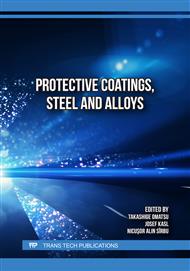p.3
p.13
p.23
p.31
p.39
p.45
p.53
p.63
Weld Cold Cracking Susceptibility in SKD 11 Die Steel during MAG Welding Using Implant Testing
Abstract:
This study aims to evaluate the cold cracking resistance of SKD 11 cold work tool steel during Metal Active Gas (MAG) welding. The experiments were conducted using implant testing in accordance with ISO 17642-3. The investigation focuses on critical factors, including tensile stress levels, lower critical stress (LCS), and time to failure (TTF). Additionally, the influence of tempered welds (Double weld passes) on fracture behavior was investigated. The experimental results revealed that the fracture surfaces of the specimens could be distinctly categorized into quasi-cleavage and final rupture region. These regions varied based on stress levels and the application of tempering heat treatment. Implant testing showed that fracture predominantly occurred in the coarse-grained heat-affected zone (CGHAZ). The time to failure of implant specimens increased as the stress level decreased. Tempered welds exhibited a lower TTF rate compared to single welds. Specifically, the LCS of single welds was approximately of 70 MPa, meanwhile tempered welds exhibited an LCS of approximately of 72 MPa. Hardness profiles were measured across the weld metal, heat-affected zone (HAZ), and base metal. The highest hardness values were observed in the CGHAZ, with an average peak of 770 HV10. However, in the case of tempered welds, the hardness value reduced to 650 HV10. Microstructural examination of the HAZ indicated a predominant martensitic matrix. The tempered weld-HAZ exhibited a finer structure with a mixed size distribution of alloy carbide particles within the martensitic matrix. These findings clearly demonstrate the high hardenability of SKD 11 cold work tool steel. The hardness value in the CGHAZ suggests its susceptibility to lower cold cracking resistance. Based on LCS experiments, tempering of the weld insignificantly enhances cold cracking resistance. This research provides valuable insights for designing suitable welding procedures to avoid cracking risks in future applications.
Info:
Periodical:
Pages:
3-11
Citation:
Online since:
October 2025
Authors:
Keywords:
Price:
Сopyright:
© 2025 Trans Tech Publications Ltd. All Rights Reserved
Share:
Citation:


